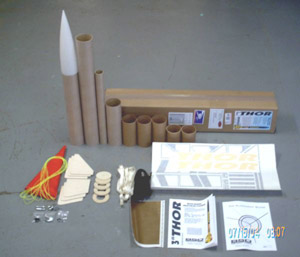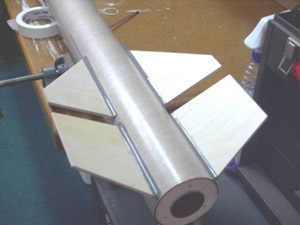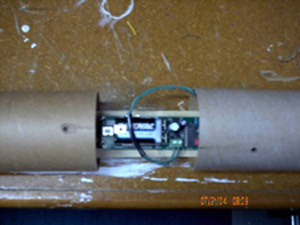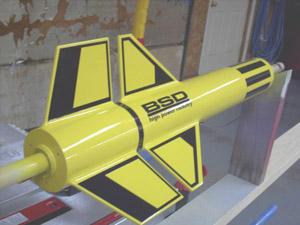BSD High Power Rocketry Thor (3")
BSD High Power Rocketry - Thor (3") {Kit}
Contributed by Joseph Michel
| Construction Rating: | starstarstarstarstar_border |
| Flight Rating: | starstarstarstarstar_border |
| Overall Rating: | starstarstarstarstar_border |
| Manufacturer: | BSD High Power Rocketry  |

Brief:
I wanted a 3" BSD THOR ever since they first came out. I really like the
idea of having smaller, high performance rocket. After doing a couple of
scratchbuilt HPR rockets, I felt that building a kit would be a nice break from
designing rockets and chasing parts for them.
This rocket is 3" in diameter, and stands 64" tall. It has six fins and is dual deployment capable. My completed rocket weighed 5lbs 1oz ready to fly when configured for dual deployment.
Construction:
The 3" BSD THOR comes in two variations, one in 38MM and the other in
54MM. I chose the 38MM version because it was a little easier on the wallet.
The basic kit includes the following components:
- 1 x 3" plastic nosecone
- 1 x 17" airframe tube
- 1 x 10" airframe tube
- 1 x 24" airframe tube
- 1 x 17" 38MM motor tube
 3 x 6" airframe couplers
3 x 6" airframe couplers- 2 x 4" airframe couplers
- 2 x 3" bulkheads
- 3 x 3" to 38MM centering rings
- 6 x 1/8" plywood fins
- 2 x 1" nylon straps 45" long w/ grommets
- 1 x 25' section of 9/16 tubular nylon
- 1 x 30" parachute
- 1 x Decal set
- 1 x Instructions manual and fin template
The kit also included one ¼ x 20 eyebolt, one 3/16" quick link, two 6-32 T-nuts, two 6-32 screws, two motor clips, eight reusable plastic rivets and two rail buttons. I was impressed with all the components. They were of good quality. BSD seemed to think of everything one would need to complete and fly this rocket. My only complaint is that one of the decal sheets seemed to have been stepped on. They were crinkled, and there was dirt and fuzz in between the vinyl decal and backing sheet. This was a minor annoyance that proved to be no big deal.
 I started by building the motor mount first, epoxying
the front and middle centering rings to the motor tube. At this point, I
decided to replace the nylon recovery strap with 5' of tubular Kevlar. I did
this because a 3" airframe is too small to get in and replace a nylon cord
if it became heat-damaged. After that was complete, the motor mount was
installed in the booster section airframe. I cut the fin slots, and ran in to
my first gotcha. The instructions say to cut the slots 3/16" wide, however
the fins are only 1/8" thick. I carefully cut in 1/8" wide fin slots
in the positions and spacing called out in the directions. Next I installed all
the fins, which went smooth. I left off the rear centering ring so that I could
do internal fillets on the lower fins. I installed machine inserts in the
rear-centering ring so I could use my PML motor retainer instead of the
supplied motor retention. I felt that the PML retainer would be an easier
solution for retaining the variety of 29 and 38MM motors that I would be flying
this rocket on. This was my personal preference, and is not a ding on the kit
or its components.
I started by building the motor mount first, epoxying
the front and middle centering rings to the motor tube. At this point, I
decided to replace the nylon recovery strap with 5' of tubular Kevlar. I did
this because a 3" airframe is too small to get in and replace a nylon cord
if it became heat-damaged. After that was complete, the motor mount was
installed in the booster section airframe. I cut the fin slots, and ran in to
my first gotcha. The instructions say to cut the slots 3/16" wide, however
the fins are only 1/8" thick. I carefully cut in 1/8" wide fin slots
in the positions and spacing called out in the directions. Next I installed all
the fins, which went smooth. I left off the rear centering ring so that I could
do internal fillets on the lower fins. I installed machine inserts in the
rear-centering ring so I could use my PML motor retainer instead of the
supplied motor retention. I felt that the PML retainer would be an easier
solution for retaining the variety of 29 and 38MM motors that I would be flying
this rocket on. This was my personal preference, and is not a ding on the kit
or its components.
When all the filleting was complete, I tried to install the rear-centering ring, and ran in to another gotcha. I had cut in the lower fins 3/16" from the end of the tube per directions. The rear centering ring was ¼" thick, so it would not seat flush with the end of the bodytube. The solution ended up being cutting groves in to the backside of the rear centering ring to let the fin in to it, and allow it to seat flush with the end of the body tube.
 With the booster section complete, I moved on the to
electronics bay and payload section. I decided to hold the payload section to
the electronics bay with 8-32 screws instead of the supplied plastic rivets.
Again, this was due to personal preference, is not a ding on the kit or its
components. I don't have the fingernails or patience to use plastic rivets. I
drilled screw holes in the airframe and couplers, and hardened the edges with
thin CA. After the CA was dry, an 8-32 tap was run through each hole to thread
it. This creates nice smooth clean threads in the cardboard. The rest of the
build focused around setting up the electronics bay for use with my Missile
Works RRC2 altimeter.
With the booster section complete, I moved on the to
electronics bay and payload section. I decided to hold the payload section to
the electronics bay with 8-32 screws instead of the supplied plastic rivets.
Again, this was due to personal preference, is not a ding on the kit or its
components. I don't have the fingernails or patience to use plastic rivets. I
drilled screw holes in the airframe and couplers, and hardened the edges with
thin CA. After the CA was dry, an 8-32 tap was run through each hole to thread
it. This creates nice smooth clean threads in the cardboard. The rest of the
build focused around setting up the electronics bay for use with my Missile
Works RRC2 altimeter.
Finishing:
 When the build was complete, all the bodytube spirals
and woodgrain were filled with Elmer's Fill ‘N Finish prior to primering.
I chose to go with the stock color scheme, so the booster section was painted
yellow and the altimeter bay and payload section were painted black. Once the
paint was dry, the decals were put on. Decaling was a real pleasure, as BSD's
decals are top notch. Once the decals were applied, the rocket received a
clearcoat finish. The finished rocket gets a “10" on the gawk scale
When the build was complete, all the bodytube spirals
and woodgrain were filled with Elmer's Fill ‘N Finish prior to primering.
I chose to go with the stock color scheme, so the booster section was painted
yellow and the altimeter bay and payload section were painted black. Once the
paint was dry, the decals were put on. Decaling was a real pleasure, as BSD's
decals are top notch. Once the decals were applied, the rocket received a
clearcoat finish. The finished rocket gets a “10" on the gawk scale
Construction Rating: 4 out of 5
Flight:
Flight day did not go as planned. My initial plan was to fly it single deploy
on an H-128, then an H180, and finally dual deploy on a J-350. I quickly found
out that the 4" deep bay in the booster section is just too small for a
good length of harness, heat pad, and parachute too. It was also very difficult
to just get in 15' of harness, heat pad and streamer for dual deploy. I
scrapped the H-128 and flew it dual deploy on the H-180. This flight was great!
I had planned on flying it on a J-350 next, but low cloud cover nixed those
plans.
Recovery:
The flight was good and straight, but the recovery was nearly a disaster. The
main and drogue harness got tangled together. The chute managed to get
un-tangled enough to open up and save the ship. I attribute the tangling
problem to flying dual deploy on a smaller motor. I feel that if it had more
fall time before the mains deployed, the airframe components would be better
separated, lessening the chance of a problem. While I'm talking about recovery,
the parachute that BSD supplies with the kit is too small. My rocket weighs
5lb, 1oz ready to fly. That translates to a 30 FPS decent rate with the stock
30" chute. I replaced the stock chute with a 48" chute to lessen the
possibility of landing damage.
Flight Rating:
4
out of 5
Summary:
I really like BSD's rockets. This was my first kit from them, and it won't be
the last. BSD makes it clear in the directions that this kit is for the
experienced flier, and I'd agree with that.
Some PROS:
- Included hardware, i.e. rail buttons, motor retention is great.
- Decals are top quality! None better!
- Finished kit flies straight and looks impressive
- Kit was priced within reach
Some CONS:
- Parachute too small
- Errors in the directions
- Parachute bay in the booster section could be bigger.
Overall Rating: 4 out of 5

The following excerpt is from "Extreme Rocketry". The intention is to allow guests to get a basic feeling about a kit. We strongly suggest that you get a copy of the referenced Extreme Rocketry and read the entire article. Inside you will find many helpful hints in construction as well as other useful information. For more information, use the link above.
(Extreme Rocketry - July 2004 - page 38 - by Kevin Trojanowski )

- "The 3 inch THOR is the little brother of the original 4 inch THOR offered by BSD."
- "...visually identical to the 4 inch version, but differs in some structural details."
- "...includes either a 38mm or 54mm motor mount..."
- "The kit compes packaged in a sturdy cardboard box, with the smaller parts of the kit seald in plastic bags."
- "All the neccessary components to complete the kit are included, short of adhesives, paint, sandpaper, etc."
- "...five couplers ...the kit uses the extra couplers to make much of the length of the tube double-walled for additional strength."
- "Most of the steps include either a black & white photograph or a drawing..."
- "Some of the photographs could have been a bit better..."
- "...I discovered a problem - the middle centering ring was in the middle of the forward fin slots! ... I contacted Mark (BSD) to dicuss this with him,... He got back to me later that day... the instructions were indeed incorrect,... The next day, he contacted me to say that new instructions were in the mail and to ask what parts I needed to have replaced... My hat is off to Mark for promptly recognizing and fixing the problem, as well as his attitude in working with me on the problem."
- "...I was surprised by how solid the tubes felt after installing the extra couplers as internal reinforcements."
- "... adapt the kit for dual deployment. The instructions include additional information to assist the builder with this adaptation."
This looks to be a fine kit from BSD. It is hybrid compatible which allows for many motor options. The manufacturer is reported to be very helpful and stood behind his product when a mistake was found. The only negative mentioned is that the tubes were not pre-slotted. This may not even be a negative depending on the builder.
 |
 |
Flights
 |
 |
P.M. (August 10, 2005)
 |
 |
T.M. (June 22, 2005)